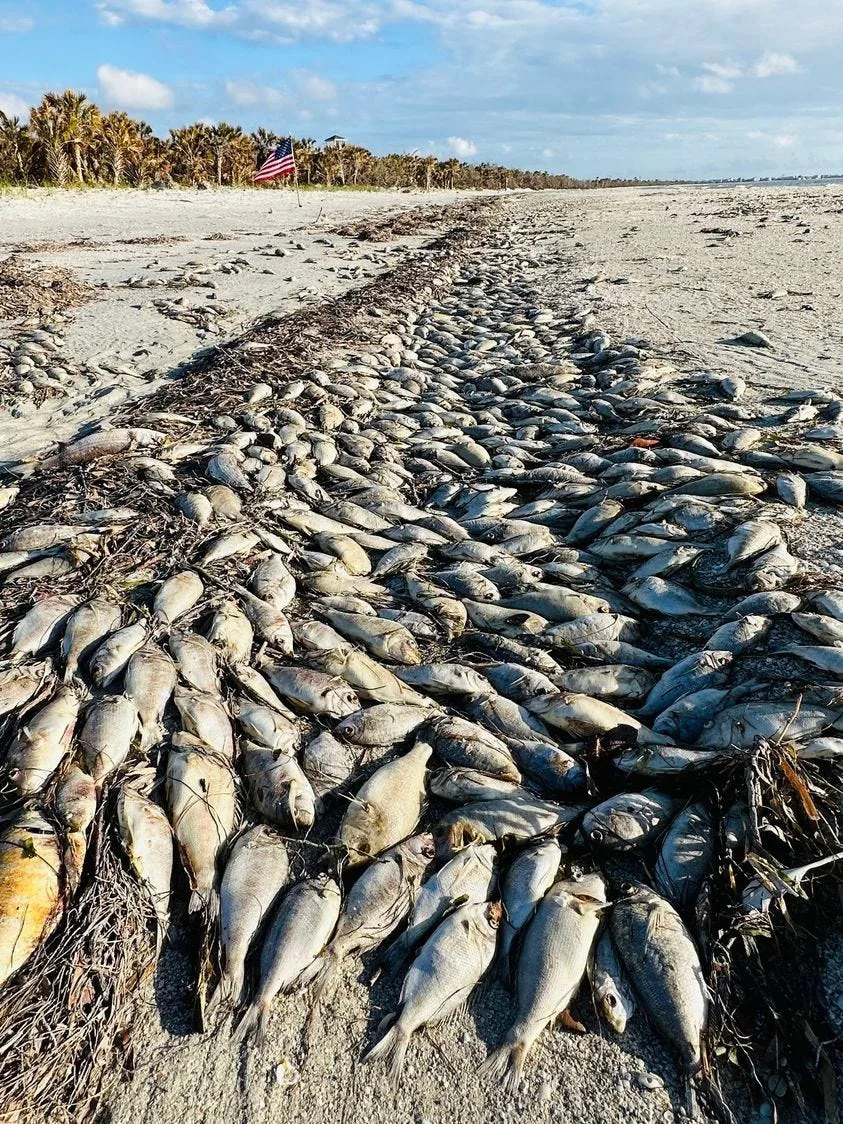The Fort Myers News Press
Red tide update: State report shows toxic algae levels from Sarasota south to Marco Island
Chad Gillis, Fort Myers News-Press – November 17, 2022
Scientists are saying a red tide bloom that’s lingered along the coast for a few weeks is now being fed by nutrients running off the landscape in the wake of Hurricane Ian.
Red tide (Karenia brevis) is a naturally occurring organism in the Gulf of Mexico that sometimes blooms to toxic levels.
But research shows that nutrients from farm fields, lawns and septic tanks fuel red tide blooms close to shore — making them more frequent, longer-lasting and more intense.
“I don’t see any good evidence that hurricanes initiate a red tide, but once you have a red tide started, runoff will make it worse,” said Larry Brand, a water quality expert, scientist and professor at the University of Miami.
Fish kills: Red tide bloom moves into Lee County waters as fish kills reported in Pine Island Sound
Florida red tide map: Check the current status
Why is it still so hot? Cold front to break up string of above-average highs, for a day
Ian didn’t create the conditions for the original bloom; but rain water and storm surge has helped fuel the bloom, which now stretches from the Sarasota area south to Marco Island.
Counts of 1 million cells per liter and higher have been reported at multiple locations along the Southwest Florida coast.
Dead fish litter many beaches in the region, and the Florida Department of Health in Collier County issued an exposure advisory Wednesday.
DOH agrees with Brand, that nutrients flowing off the landscape contribute to the intensity and duration of the bloom.

“Once inshore, these opportunistic organisms can use nearshore nutrient sources to fuel their growth,” a Wednesday DOH press release reads. “Blooms typically last into winter or spring, but in some cases, can endure for more than one year.”
What should Southwest Florida residents do?
DOH says people who live along the coast should even check their air conditioning filters.
“Residents living in beach areas are advised to close windows and run the air conditioner, making sure that the A/C filter is maintained according to manufacturer’s specifications,” DOH says. “If outdoors near an affected location, residents may choose to wear masks, especially if onshore winds are blowing.”
Carly Jones, spokeswoman for the Florida Fish and Wildlife Conservation Commission — the state agency charged with monitoring red tide, said offshore winds can help push the contaminated waters and the microscopic algae away from the coast.
Lake O levels: Herbert Hoover Dike around Lake O remains safe during Hurricane Nicole
More: Cassani calling it quits after six years as Calusa Waterkeeper for Caloosahatchee system
The latest FWC report show the strongest red tide counts have been found in northern Lee and Sarasota counties.
“Some people experience respiratory irritation (coughing, sneezing, tearing and an itchy throat) when the red tide organism is present and winds blow onshore,” Jones wrote in an email to The News-Press. “Offshore winds usually keep respiratory effects experienced by those on the shore to a minimum. The Florida Department of Health advises people with severe or chronic respiratory conditions, such as emphysema or asthma, to avoid red tide areas.”
Red tide can contaminate shellfish, and the DOH recommends against collecting and eating shellfish from this region at this time.
Locally caught, properly cleaned and cooked fish can be eaten, the press release says.
DOH recommends washing yourself and all clothing if you make contact with waters containing the toxic algae.
Hurricane Irma also stirred nutrients in toxic algae bloom in 2017
Calusa Waterkeeper John Cassani has been monitoring the bloom online.
“I’m hearing people aren’t seeing as many gamefish species as compared to (Hurricane) Irma (2017),” Cassani said. “It’s mostly foraging fish but most are decayed to the point you can’t determine the species.”
Hurricane Irma stirred up nutrients in the Lake Okeechobee/Caloosahatchee River system five years ago, and the following summer was virtually lost to a massive red tide and blue-green algae bloom in the river.
Lee County was part of a state of emergency for both blooms.
Some scientists have speculated that Hurricane Ian’s aftermath will cause similar conditions between now and the spring of 2024.
The Hurricane Irma-fed red tide lasted from the fall of 2017 until the spring of 2019.
“It’s a neurotoxin,” Cassani said. “There are neurological symptoms that have been defined in response for red tide. And people with asthma are showing up in emergency rooms. There’s an influx often during a bloom. It’s an unregulated contaminant.”
